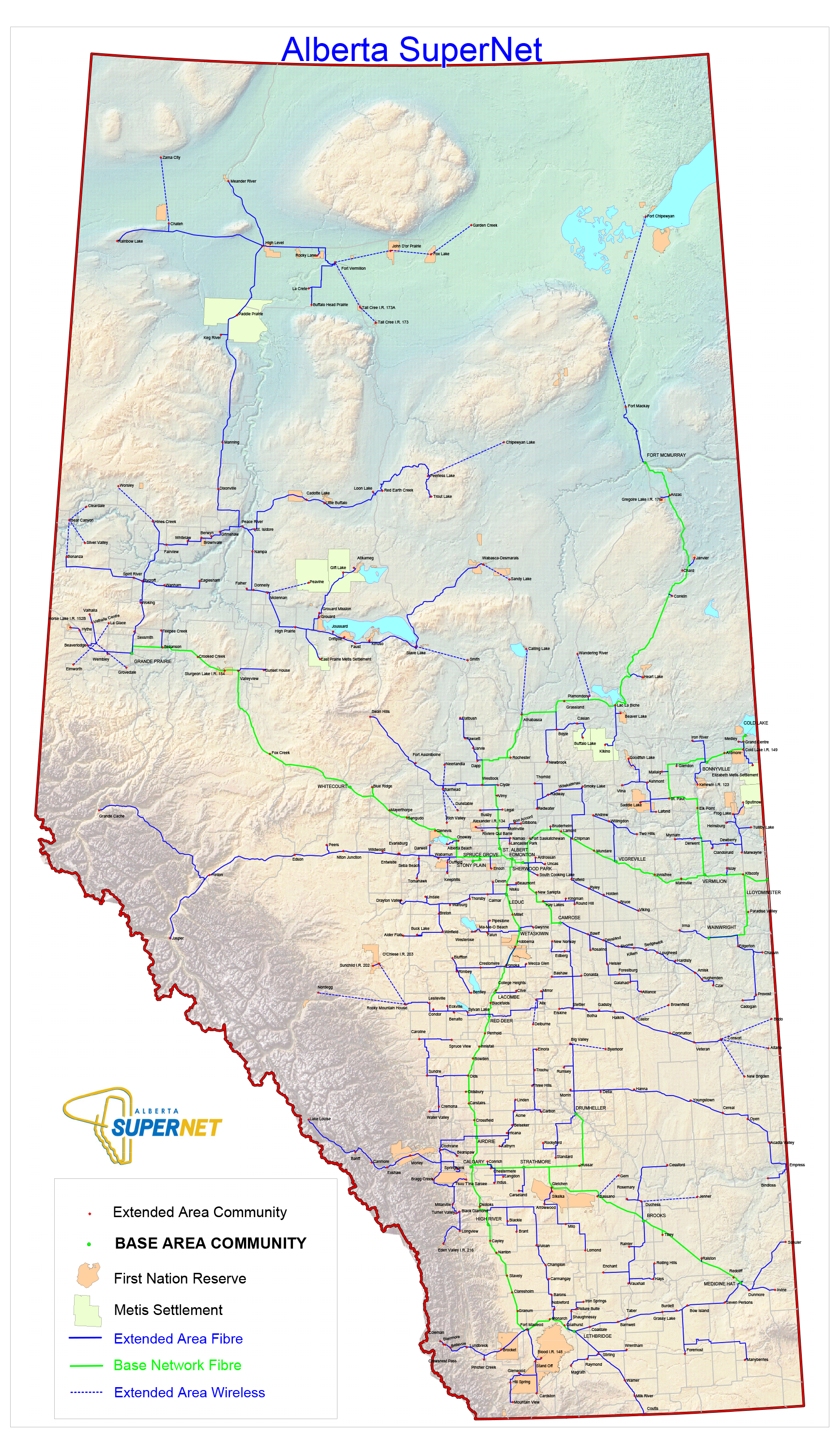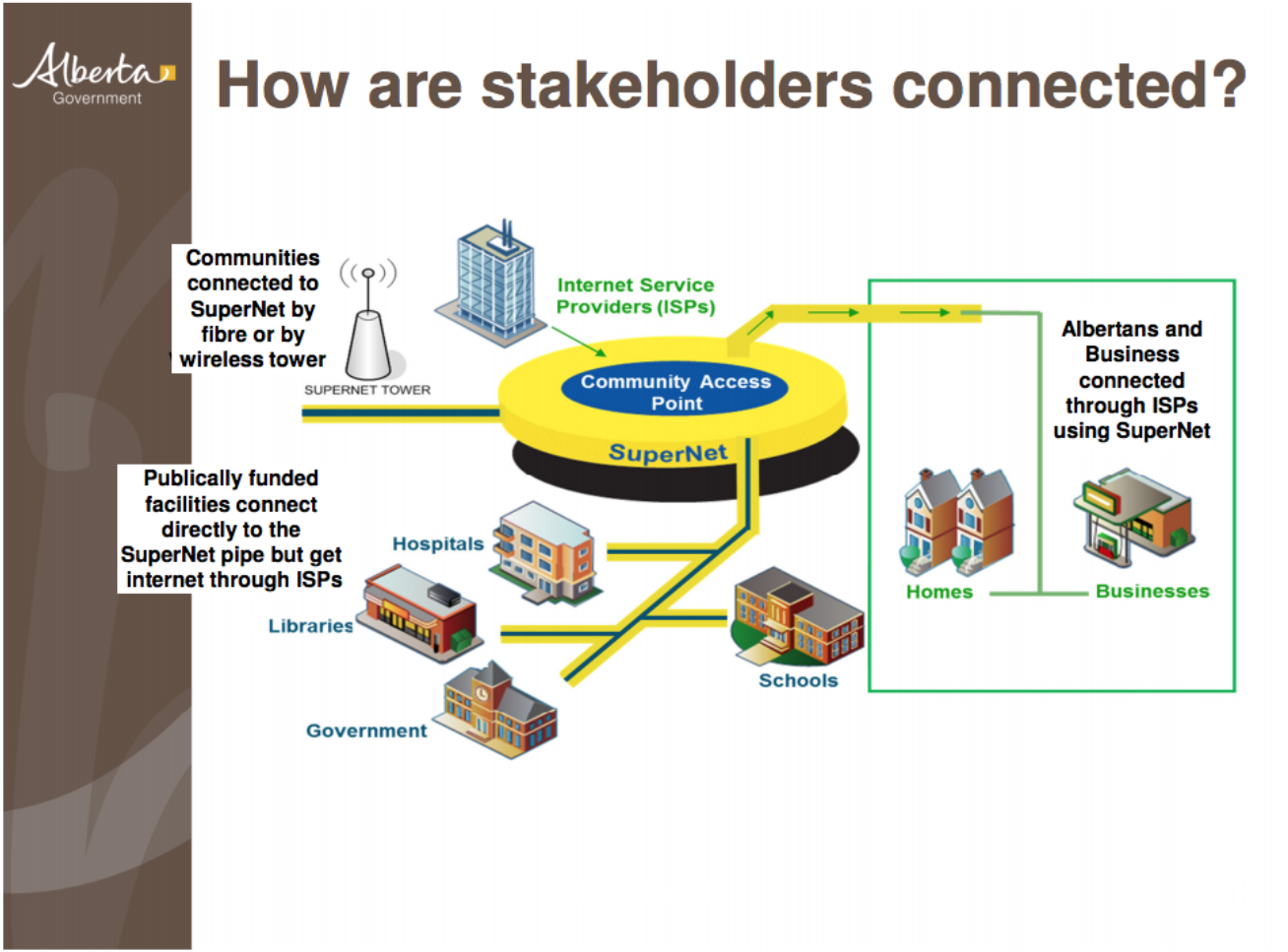The Alberta SuperNet is a network of fibre-optic cables and wireless connections across Alberta in over 400 communities. It consists of more than 13,000 km of fibre and 2,000 km of high-speed wireless links. The SuperNet connects more than 3,300 government services and public institutions, including over 1,950 learning centres, 650 government locations, 300 healthcare facilities, 300 libraries, and 90 Alberta municipalities, with more schools being built and connected each year. Currently, 43 First Nations communities in the Treaty 6, 7 and 8 regions, and eight Métis settlements, have SuperNet connectivity within or adjacent to their communities.
In operation since 2005, SuperNet was built to provide broadband network connectivity to Alberta public organizations and business users. The network is also leveraged by dozens of private service providers to deliver internet and other services directly to customers throughout the province14.
Figure 7. Map of the Alberta SuperNet backbone as it was originally deployed to 429 Alberta communities. Some network pathways have been modified since, but this map shows the scope of provincial coverage by the network15. Of note: there is no longer a Base Area Network and Extended Area Network, as Bell manages the entire network.
The SuperNet was a $295 million strategic infrastructure investment by the Government of Alberta ($193 million) and Bell Canada ($102 million). When construction was completed in 200516, the final cost, including subsequent extensions, was approximately $330 million17. At the time of completion, the SuperNet was the first jurisdiction-wide fibre optic network in North America.
The SuperNet was originally divided into two networks: a primary backbone made up of 27 Base Area Network (BAN) locations, and an additional 402 Extended Area Network (EAN) locations. The operation and management of the SuperNet was originally contracted to Axia SuperNet Ltd (a wholly owned subsidiary of Axia NetMedia Corporation) on the Extended Area Network (EAN), and to Bell Canada on the Base Area Network (BAN). All public sector customers, whether on the BAN or the EAN, were managed by Axia. The initial contract agreement spanned 2005-2015, and was extended from its initial 10-year term for an additional three-year period until June 30, 201818.
Governed by Service Alberta, a ministry of the Government of Alberta, the SuperNet now entered a second contract phase. In early 2016, Service Alberta issued a Pre-Qualification Request (PQR) for provincial broadband services in order to identify potential service providers, review business and technical requirements, and gather current information on industry trends19. In May 2016, telecommunications operators Axia, Bell, TELUS, and Zayo were pre-qualified to participate through the PQR process20.
After the PQR process concluded, in late 2017, Service Alberta issued a Request For Proposals (RFP) to replace the initial, extended SuperNet contract from the shortlist of Bell and Axia, as by this time TELUS and Zayo had withdrawn from the competition. The RFP was awarded to Bell Canada, who became the sole contract holder for the SuperNet as of July 1, 2018. To ease the transition process, Bell purchased Axia Netmedia Corporation and began integrating SuperNet into its national network21.
SuperNet Operating Model
The Alberta SuperNet is a backhaul (or ‘middle-mile’) network that connects on one end to local access networks (‘first-’ or ‘last-mile’ connections), and on the other end to separate networks that connect to the internet. Today, the SuperNet serves both public sector customers through a unique suite of services (see Table 2), as well as business and wholesale customers.
For public sector customers, the Government of Alberta set a universal fee structure across the province for monthly flat-rate services, irrespective of a subscriber’s physical location. This model contradicts conventional private sector telecommunications billing practices, where rates tend to be lowest in urban centres and highest in rural communities.
The SuperNet does not directly serve residential subscribers. It is intended to provide affordable wholesale fibre access to local ISPs. The ISPs can then provide last-mile connectivity and internet service to residents of SuperNet communities. For a partial list of ISPs providing services through the Alberta SuperNet, please see Appendix A3.
Figure 8. SuperNet - How are stakeholders connected? Source: June 8, 2016 Service Alberta IM Aware presentation22.
Public sector organizations that utilize the SuperNet include Government of Alberta ministries, schools, health facilities, libraries and municipalities. School districts receive subsidies of $800 per month for each school site, which may only be spent on connecting to the Alberta SuperNet23. Alberta Libraries, through the provincial Ministry of Municipal Affairs, subsidizes SuperNet annual costs for libraries participating in the Public Library Network by $1.85 million per year24.
SuperNet NGN SERVICE
Base package of 100 Mbps: $898/month
- 90 Mbps Basic
- 5 Mbps Interactive
- 5 Mbps Real Time
Additional megabits available in increments of 1 Mbps
- Basic - $0.75/Mbps
- Standard - $2.50/Mbps
- Interactive - $4.00/Mbps
- Real Time - $11.00/Mbps
SuperNet LINE RATE SERVICE
1,000 Mbps Line Rate Service: $1098/month
- Includes up to 10 Layer 2 or Layer 3 VPNs, with additional VPNs available upon request at no additional cost.
- Up to 4 physical 1 Gbps Ethernet Ports.
- For customers with large bandwidth requirements, but who don’t need multiple classes of service.
- Service can be leveraged by customers with a sophisticated network and IT team, who would like more control over their network.
SuperNet 10 Gbps SERVICE
10 Gbps Service:
$5,098/month
- Includes up to 10 Layer 2 or Layer 3 VPNs, with additional VPNs available upon request.
- Includes 1 Physical 10 Gbps Ethernet Port.
- For customers with very large bandwidth requirements, but who don’t need multiple classes of service.
- Service can be leveraged by customers with a sophisticated network and IT team, who would like more control over their network.
New SuperNet Services since July 1, 2018
Most of the legacy services (re: from the initial contract) on SuperNet were based on using Multiprotocol Label Switching (MPLS) based Internet Protocol Virtual Private Networks (IP VPNs). These were retained in the new contract, but several other services and network requirements were added. These included ethernet (WAN based optical ethernet) and wavelength services26.
As the latter two services require upgraded network devices to implement, they are not immediately available across the entire SuperNet network. Specifically, the wavelength service was initially available in Edmonton and Calgary, and outside of these two cities, was considered on a case-by-case basis27.
Additionally, SuperNet was required to connect to all Internet Exchanges located in Alberta. Bell has fibre feeds and electronics located at both the Calgary (YYCIX) and Edmonton (YEGIX) exchanges. No peering requests from SuperNet customers have been made as of the writing of this report28.
SuperNet and Rural Last Mile
Section 13 (page 187) of the 2018 SuperNet contract refers to support for broadband throughout Alberta, particularly in rural and remote areas of the province, that is required by the SuperNet contractor, Bell.
It specifically states that “Any utilization of [Government of Alberta] Network Infrastructure by the Contractor for providing products and services to Commercial Clients or for any other purposes not specified in the Contract must support the provision of broadband in Alberta.”
Further clauses spell out that the SuperNet is to be utilized for wholesale commercial services in the same way as other carrier class infrastructure. This clarifies that the SuperNet is to be utilized in a manner that gives a fair and competitive advantage to all ISPs in the province.
In addition, at the time of signing the 2018 contract, Bell was required to submit a “Plan for Alberta” document that outlined its commitments to supporting rural broadband. Bell’s rural broadband plan had to include:
- Investments for expanding internet access at targets that meet or exceed 50/10 Mbps
- A community-based plan for expanding internet access – 1 year horizon
- A province-based plan for expanding internet access – 3 year horizon
Bell is required to provide annual updates to the government on the progress it is making on this plan.
At the time of signing the contract, Bell was also required to create a Contractor Contribution Fund, made up of a redacted percentage of its annual revenue, to support rural broadband in Alberta. Currently, there are no publicly available plans on how the Contractor Contribution Fund will be spent, allocated or accessed.
Additional broadband support involved provisions for wholesale services in SuperNet facilities and at other locations to facilitate lower installation costs. Additional required supports include:
- Bell is contractually obligated to support the provincial government’s priorities for broadband deployment in Alberta, with an emphasis on rural communities.
- According to the contract these priorities include:
- transport, middle mile, and final mile infrastructure
- unserved communities, and indigenous communities
- creating partnerships with existing ISPs and municipalities
- creation and support of new ISPs
- other opportunities (e.g. free Wi-Fi hotspots at community gathering places, sponsoring training, and other learning supports)
References
14Bell Canada. Bell awarded SuperNet contract by the Government of Alberta. Newswire, 03 July 2019.
15Service Alberta. Layout:4 (servicealberta.ca).
16Government of Alberta release.cfm (alberta.ca). Accessed 10 February 2021.
17Middleton, C. and Given, J. (2010) Open Access Broadband Networks in Alberta, Singapore, Australia and New Zealand. The 38th Research Conference on Communication, Information and Internet Policy, 1 October 2010. Accessed 10 February 2021.
18Axia NetMedia. Continuity of Services Assured for Axia’s Alberta Customers. Newswire, 29 August 2013. Accessed 10 February 2021.
19Service Alberta. Procurement Services. Pre-Qualification Request (PQR) For Provincial Broadband Services PQR 288-PA-PBS, Reference number: AB-2016-01170, 16 February 2016.
20Alberta Purchasing Connection. Opportunity Notice: Provincial Broadband Services, Awarded Vendors, 05 May 2016.
21Interview with Bell SuperNet Contract Manager, 08 February 2021.
Service Alberta Artifact. Accessed 5 July 2016.
23Funding Manual for School Authorities 2020/21 School Year, C3.3 SuperNet Service Funding and H1.1 Funding Rates for School Jurisdictions - School Based Grants.
24Government of Alberta. Public library statistics | Alberta.ca.
25Axia. E-mail communication: Service Alberta and Axia announce newly available suite of SuperNet services for all government ministries, 18 September 2015.
26SuperNet Network Services Contract (#288PA-22559) Schedule 02B.
27Interview with Bell SuperNet Contract Manager, 08 February 2021.
28Interview with Bell SuperNet Contract Manager, 12 February 2021.

